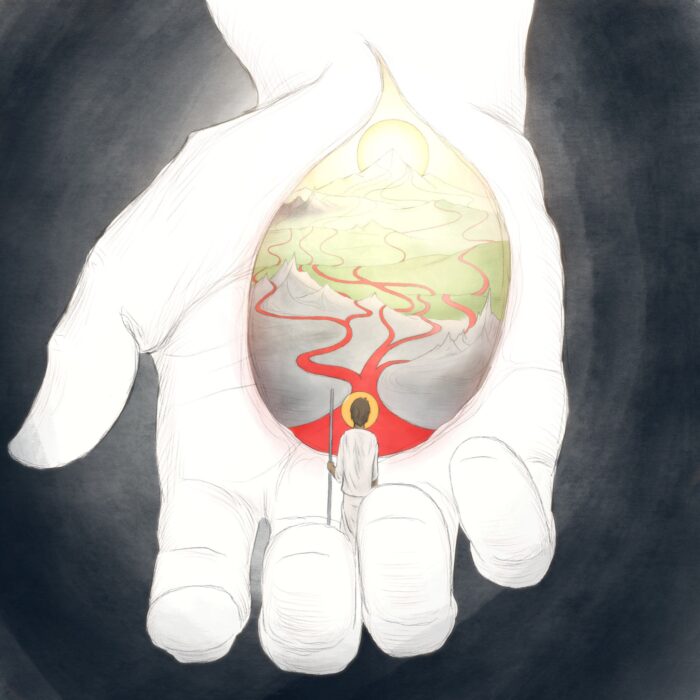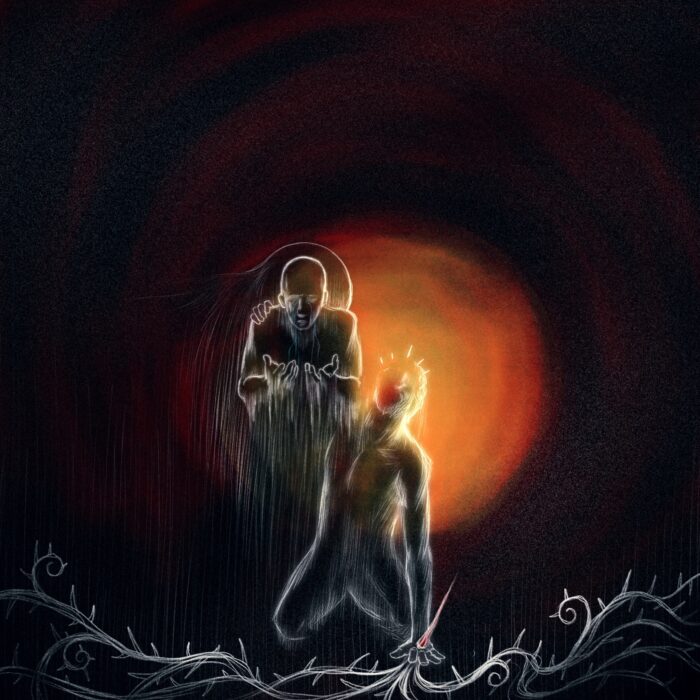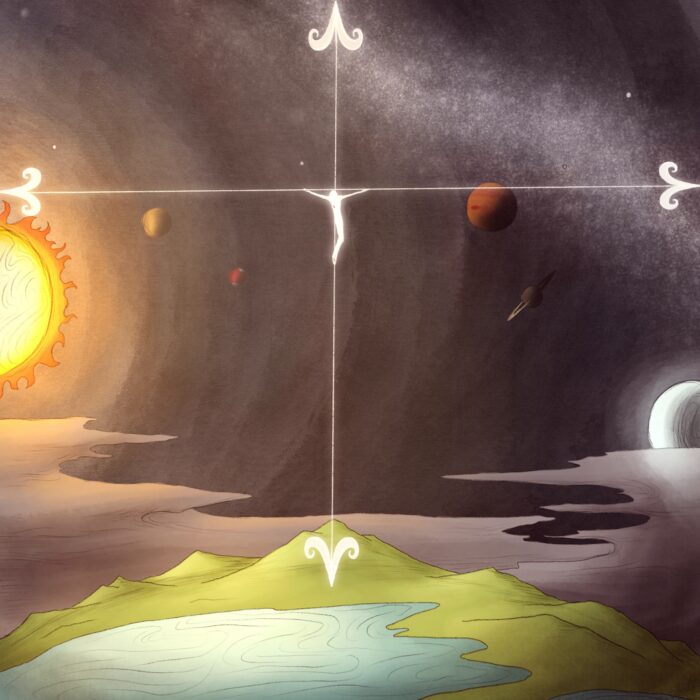
Psalm 116:6-9, “YHWH preserves the simple; when I was brought low, he saved me. Return, O my soul, to your rest; for YHWH has dealt bountifully with you. For you have delivered my soul from death, my eyes from tears, my feet from stumbling; I will walk before YHWH in the land of the living.”
When sinking down, in chaos bound
And ‘compassed round with fear
To Him I look, who chaos took
And so, in fear, is near.
Return, my soul, my weary soul
To Him who is your rest
His wounded side, now glorified,
A refuge in His breast.
My soul, my eyes, my feet, my life
Delivered now from woe
And with the one who bore my strife
I’ll walk in joy, I know.
_____________________
In Psalm 116 we find the account of someone who has been dragged into the depths of suffering and difficulty—imaged in verse 3 as the grave itself—only to be redeemed from that shadow and brought into the life and light of YHWH. Ultimately, Jesus Christ—crucified and risen—is this sufferer. In His death He suffers the agonies and dies the death of all those who have called or will ever call upon YHWH for salvation, and in His resurrection, He achieves and embodies every instance of salvation His people will ever experience—from the regeneration of their soul, to the healing of a sickness, to their own final resurrection on the Last Day. Every night of agony that God’s people face is first the agony of their God on the cross, and every morning of joy that breaks upon the saints is first the joy of their God in His resurrection.
With that being said, I decided to illustrate this account of suffering and salvation by making the crucified and risen Christ the centerpiece.
At the left hand side of the image is the depiction of the sorrows and sufferings recounted in verses 3 and 6. The tumultuous waters and sea serpents are intended to depict not merely the Psalmist’s plight (v.3), but—drawing on the Old Testament’s depiction of the sea and sea monsters as images of pre-creational chaos—the “un-making” of the orderly cosmos, a descent back into the formless and void state that obtained prior to Genesis 1:2. Whenever we fall away from the Lord—whether in heart, mind, or body—we are moving toward dis-integration, toward formlessness. This dis-integration is powerfully represented in the division of soul and body at death, and seems to be part of the Psalmist’s sufferings, especially in verse 3.
However, when the Psalmist was brought low, YHWH saved him. How? We are not told in this passage, but as I mentioned above, ultimately all salvation is grounded in, enabled by, and secured through the death and resurrection of God incarnate. How did YHWH save the death-ensnared Psalmist? By Himself becoming ensnared in death. The serpents are surrounding the arm of Christ and preparing to strike Him, this is an attempt to portray that—in order to save us from our plight (whether death or sorrow or fear or damnation)—God Himself in Christ had to bear precisely that plight in Himself. The woman—who here represents the individual Psalmist as well as the people of God collectively—is held secure in the wounded palm of Christ. That she is in the wound is crucial to note since, again, it is only in His suffering our suffering that God in Christ meets us in and so redeems us from all suffering.
Moving to the center panel. Here I am depicting verse 7. Ultimately the rest of the saint’s soul is in YHWH Himself, and for the one who knows YHWH post-cross, that means that their rest is the crucified Jesus Christ who is raised and lives forevermore. God in Christ—who has borne in Himself every unrest that we can ever face, has passed through them all, and now stands in risen glory—is Himself our resting place. In this image, then, the woman rests in the wounded side of Christ. She is in the posture of an infant in her mother’s womb because, the heart of God (pierced by and opened to sinners with Calvary’s spear) is something like the “womb” in which the Christian soul is carried through this life. Therein by faith we rest, are nourished and protected until the day we are finally “born” into a fuller fellowship with our God in the “Land of the Living.” Note that the woman’s gaze is toward the risen Jesus, who’s face is radiant with the light of His resurrection and who now wears His wounds as a crown of glory—the emblems of sin, suffering, death, and damnation transfigured into heralds of sovereign, victorious love. In that glorified wounded one, faith apprehends the dual reality that in this world we will have sorrow and yet we must take heart, because our risen Lord has overcome the world (Jn 16:33)—turning sorrow into joy (Jn 16:20).
Finally, on the last panel, we see verses 8-9 illustrated. Paul’s citation of verse 10 in 2 Corinthians 4:13 makes it clear that the Psalmist’s belief that he will “walk before YHWH in the land of the living,” is not an assurance of health or healing in this life, but an assurance of our final resurrection. Just as our Lord and God—who is also our Brother, Head, and Husband—just as He has been raised bodily from the dead, so too will all those in Him be raised. Our deliverance from death, tears, and stumbling is partial in this life, but the day is coming when that deliverance will be complete, and we—with the Psalmist and with Paul—will be raised up with Christ and will be brought with joy unbearable into His presence. This is the final hope hinted at in the right hand panel.
See that the woman, though standing on her own, remains rooted in the wounded hand of her Lord—for the everlasting ages, every good we enjoy will be ours only by virtue of our indivisible union to the slain and risen Christ. She looks toward the face of the risen Jesus because He Himself is the radiance of the glory of God who—revealing the Father through the illuminating beams of the Spirit—will fill the entire regenerate universe with the knowledge of the glory of YHWH as pervasively as the waters cover the sea (Hab.2:14). You can see now that the stream of clear, blue water that flows from the pierced side of Christ—the stream who is the Spirit—flows through the heart of the New Creation and gives life wherever it goes. The chaotic waters of death and sorrow are wholly overcome and replaced by the river of the water of Life, released on Calvary, and flowing forever from the altar-throne of the Triune God (Rev.22:1). Springing up from this river—and also rooted in Christ’s wounds—is the tree of life, bearing its twelve fruits and sending out its leaves for the healing of the nations (Rev.22:2).
The Land of the Living is, ultimately, all of reality, raised up in Christ from the death of sin and illumined from root to branch by the all-penetrating light and life of God as He is revealed in His crucified and risen Son by the illumination of the Holy Spirit….and it is in this land that we will walk before the Lord…..this we believe and this we know, even while we are greatly afflicted (Ps.116:10).




